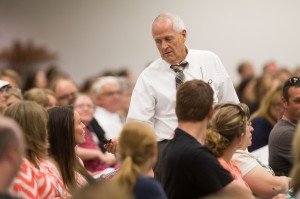
BYU Education Week’s Addiction Symposium on Monday drew crowds for the fifth straight year, but for the first time, pornography was part of the discussion.
The symposium on addiction began after a few BYU professors decided that addiction should be addressed at Education Week.
For five years now, more or less the same group of people has talked about addiction from many different angles and “a slightly different perspective,” said Benjamin Hill, a professor of psychology and addictions counselor at BYU. “We’re all spokes on the same wheel.”
Speakers’ topics range from how the brain works under addiction and how genes play a factor in addiction, to the spiritual redemptive power of grace and using scriptures as a part of recovery.
Pornography took center stage in two out of the six sessions this year. When asked why pornography was included, all of the speakers agreed that pornography is becoming more and more addictive and warrants specific attention.
“We want to connect with people so badly that when we have a void in our lives, we will turn to anything to fill it,” Hill said, explaining addicts’ behaviors. He spoke of the redemptive power of grace for those who are addicted, and how family and friends can show compassion for those who are suffering.
Jill Manning, a licensed marriage and family therapist, spoke about wives who are trying to cope with their husbands’ pornography addiction. She said spouses also suffer and need therapeutic help as well.
Out of the 11 most commonly studied addictions, sex addiction has the third highest number of negative consequences and is the fifth highest in prevalence, Manning said.
In a recent survey of 450 women whose husbands are dealing with pornography, 70 percent met the criteria for post-traumatic stress disorder and 48 percent met the requirements for moderate to severe PTSD.
She stressed that these women need recovery just like the addicts do and encouraged clergy, friends and family to remember that recovery comes in three stages. The first stage is to ensure the safety and stability of the spouse. Second, allow the spouse time to process what happened. And third, help them reconnect if they choose to.
“I’ve found that in the LDS culture, because we place such a strong emphasis on eternal families and marriage, we rush to the reconnection stage long before the couples are ready,” Manning said.
Another addition to this year’s symposium was a visit from John Volken, founder of the John Volken Academy, which is a two-year therapeutic community program that helps teach addicts how to adopt a healthy new lifestyle and assists them in finding job training.
The program is funded by Volken’s charity, which he started 15 years ago.
“Tough choices and suffering is what recovery is all about,” Volken said. “We don’t change people. We just take out the toxins from them and help them become who they were supposed to be.”
When Volken finished his presentation, many in the audience gave him a standing ovation.
Scott Steffensen, associate professor of psychology at BYU, began the day’s discussion by focusing on the neurology behind addiction. “Our brain is responsible for who we are,” he said. “As far as this life is concerned, our brain drives our behavior and our behavior changes our brain.”
Steffensen showed the visual differences between the appearance of a normal, functional brain and one under addiction. He contrasted how dopamine (the pleasure system) is influenced in those who are addicted as opposed to those who are not.
J. Dee Higley, a professor of psychology at BYU, said genes play a factor in addiction, and that people can be genetically more disposed to various types of behavior through genes such as the warrior gene (that makes people more likely to have aggressive tendencies).
Hill showed how science has proven that when a child is nurtured by a mother, that love can counteract the influence of such genes. He called addiction a “medical problem affecting us socially.”
Douglas LeCheminant, a licensed clinical social worker with LDS Family Services, spoke about the spiritual elements of recovery, focusing on how addicts can use the Doctrine and Covenants and words of the living prophets in their recovery.
He described what recovery looks like for someone who has experienced addiction, regardless of where they’re at in the journey. “The scriptures fuel the journey of recovery for many people, whether they are LDS or not,” he said.
LeCheminant announced that next month, The Church of Jesus Christ of Latter-day Saints will release 12 videos, each focused on one of the 12 steps in the church’s 12-Step Addiction Recovery Program.
“There’s never been more addiction than there is now, but there’s never been more hope that there is now,” he said.
Neurosurgeon Donald Hilton finished the symposium with a presentation about the neurology of sex addiction and pornography. He said sex addiction is like a storm that destroys all around it. Academic research that has proven that sex addiction causes the brain to shrink and change, just as it does under the presence of other addictive substances, he said.
Even so, there is hope and recovery for those who are addicted. “Recovery is a process, not an event,” Hilton said. “In the end, recovery is both a technical and a spiritual journey.”




